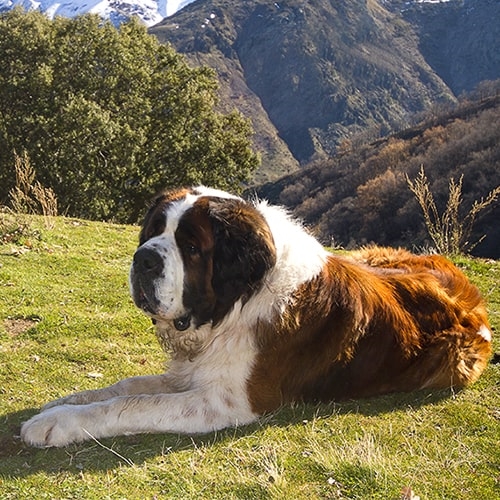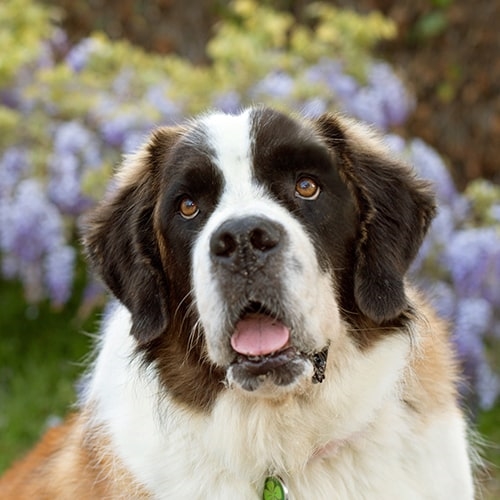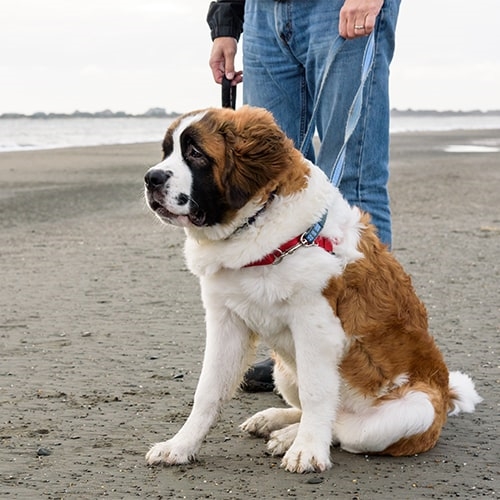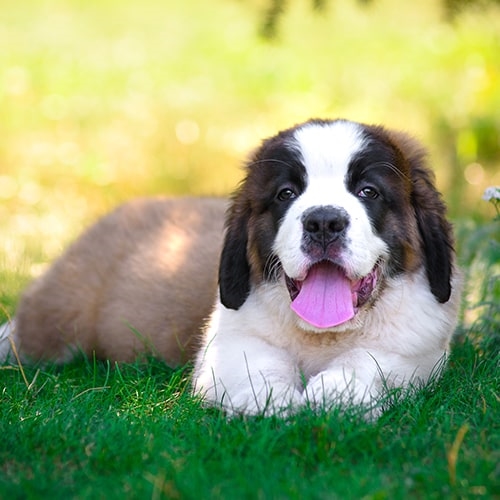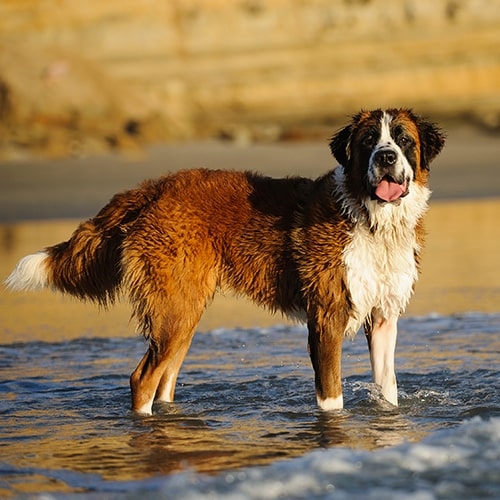| Size | Large |
|---|---|
| Average height | 70-75 cm |
| Average weight | 54kg-81kg |
| Average lifespan | Under 10 years |
| Minimum exercise (per day) | 1 hour |
| Coat length | Short |
| Minimum cost (per month) | £105 |
Saint Bernards are known for being gentle giants and suit most families as long as you have the space for a large breed. They are big shedders though so be prepared for a house full of hair all year round!
Saint Bernards are known for being patient and affectionate which is why they can be so good with families and children. They are very big and strong, so you’ll need to positively train them from a young age so they walk nicely on a lead and know how to behave in the right way.
Common health problems in Saint Bernards
While Saint Bernards are very lovely dogs and can make great pets, they are also prone to a number of health problems due to their size and appearance. Often, Breed Clubs will also be able to provide advice on what tests your breed may need and where to get these done. Make sure the parents of your puppy have had the relevant health screening to reduce the chances of your puppy being affected by these upsetting conditions.
Saint Bernards are in a group of breeds classed as ‘Category Three’ by The Kennel Club. This means they have health concerns due to the way they look. For Saint Bernards, this includes problems with their skin folds, eyes, back legs and jaw or dental issues.
Some of the conditions Saint Bernards may develop include:
- Hip dysplasia – where hip joint that doesn’t fit together perfectly, which will eventually lead to arthritis. Before breeding, dogs should be screened by x-rays through the BVA/Kennel Club Hip Dysplasia Scheme.
- Elbow dysplasia – where the elbow joint that doesn’t fit together perfectly, which will eventually lead to arthritis. Before breeding, dogs should be screened by x-rays through the BVA/KC Elbow Dysplasia Scheme.
- Osteochondrosis dissecans (OCD) – a problem with the cartilage in the elbow causing joint pain and limping.
- Cruciate ligament disease – this can cause the knee joint to become very wobbly and painful.
- Gastric Dilatation Volvulus (GDV) – where a dog’s tummy bloats and twists around on itself, which is an emergency and can be fatal.
- Dilated cardiomyopathy (DCM) - disease of the heart muscle that causes weakened contractions and poor pumping ability, leading to heart failure.
- Certain cancers – especially aggressive bone cancer (osteosarcoma).
- Skin problems around their lip folds and ear problems.
Caring for your Saint Bernard
Saint Bernards are highly intelligent and with the right socialisation and training can grow up to be good family pets. Because they’re so relaxed and calm, they can be great with people of all ages.
Saint Bernards and barking
Like any dog, your Saint Bernard is likely to make noise. What they bark at and how often will be completely down to the individual. If you’re having problems with excessive noise or barking, we recommend seeking the advice of an accredited behaviourist.
Training and socialisation
Training will have to be ongoing with Saint Bernards as they can pick up bad habits quickly and are really big dogs that can throw their weight around if they haven’t learned good manners. Using positive, reward-based training is the best way to train your dog. Training your Saint Bernard not to jump up from an early age is vital.
It’s important that Saint Bernards are well socialised as puppies so they grow into confident and happy adults. Even though they might not bark or destroy things if left alone, they should never be left for more than four hours on an average day. They prefer to be in a family environment where there’s lots to keep them busy and happy.
Exercise
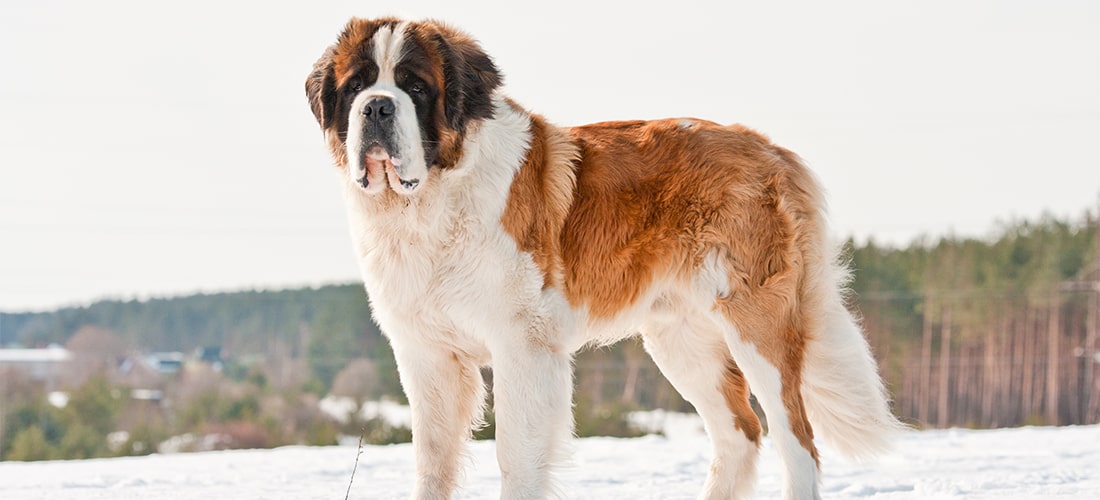
To keep your Saint Bernard fit and healthy, they’ll need at least an hour of exercise every day once they’re fully grown.
This should include walks (at least one fairly long one with some shorter ones), with extra playtime, brain games and plenty of off-lead time in a secure environment. Usually, Saint Bernards will likely be able to manage more. For those affected by joint problems (which are common in the breed) you might need to reduce their exercise depending on the advice of your vet.
Saint Bernards can be fairly good escape artists, especially if they find a weak bit of fence! You’ll need to make sure your garden boundary is sturdy and secure so your dog can stay safe and enjoy the outdoors.
Grooming
Although Saint Bernards do shed a lot, their coat needs a relatively normal level of maintenance from you. Brushing them at least three times a week will help you keep on top of all the dead hair. You may also choose to have them professionally groomed every few months.
Saint Bernards are also known for their drooling. If you have one, you’ll become very used to cleaning drool off their face, your floor and every other surface (as when they shake their heads it goes flying everywhere).
Because of their shape and droopiness around their faces, you’ll need to clean your Saint Bernard’s eyes and skin folds regularly. This can be done with a soft damp cloth. Gently wipe the area around their eyes and use another clean cloth to wipe between each of their skin folds. You’ll also need to check their ears regularly to stop any nasties and give them a clean. Speak to your vet about how regularly you should clean your dog’s ears.
Saint Bernards and children
Saint Bernards are known for being great with people of all ages – which includes children. They love nothing more than being with a family which is why so many people choose them as family pets. You should always supervise them with smaller children and adults unfamiliar with the breed, however, as they are so big they may accidentally knock them over, especially if they get a bit excited.
As with every breed, you should always teach children how to approach and play with dogs with care and kindness. Always supervise children and vulnerable adults with your Saint Bernard and make sure you can recognise the signs of unhappiness or anxiety in your dog to help avoid any conflicts.
Saint Bernards and other pets
If your Saint Bernard grows up with another pet and is well socialised, they will usually be absolutely fine with them. If you’re introducing one into a family with other pets, make sure you take care introducing them to cats and small pets and always supervise them together.
Saint Bernards are very social and will usually get along fine with other dogs. Make sure they are properly socialised to avoid any body language misunderstandings and supervise them closely for the first few introductions.
Food
Your Saint Bernard’s diet will vary depending on their age. You’ll need to feed them a complete, commercial dog food to keep them slim and healthy.
Your vet will be able to tell you how much your dog should be eating. You should feed a healthy Saint Bernard a good quality, commercially available and complete dog food and it’s usually recommended to split their daily allowance into two meals. If you give your dog an occasional treat or use treats for training, remember to take this into account and reduce their daily allowance. Treats shouldn’t make up more than 10% of their calories or they can unbalance their diet.
You should try to feed your dog at the same time every day to get them into a routine. Remember to leave a gap after eating and before exercising.
The cost of owning a Saint Bernard
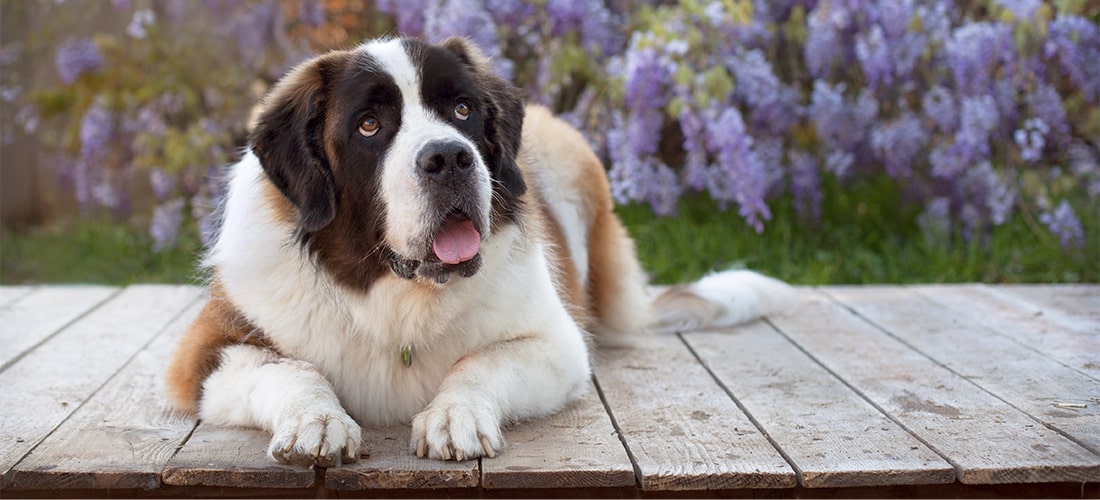
Having a Saint Bernard will cost a minimum of £105 per month after purchase and set-up costs and up to £17,000 across their lifetime.
Costs you’ll need to think about include:
Purchase costs
Adopting an adult dog from a rescue centre may be a more cost-effective option, as well as having the added advantage of offering a home to a pet without one – check if the rehoming centre you’re looking at asks for a donation for rehoming.
If instead you’re buying a Saint Bernard puppy from a breeder, you’ll need to factor in this cost. Beware unusually cheap puppies as they could come from a puppy farm. If you want to buy a pedigree puppy, we recommend looking for a Kennel Club Assured breeder as they have to do extra health tests and meet high standards.
Set-up costs
- Puppy vaccines – if you rescue a dog, reputable centres will often vaccinate them for you. Remember that ongoing booster vaccinations will be needed to continue their immunity.
- Neutering – you should usually arrange for your dog to be neutered at around 6-12 months old, though your vet will be able to advise you exactly when is best. Check prices at your local practice as these will depend on your vet and where you live. Some rescue centres will neuter any dogs they rehome, saving you this cost.
- Equipment – including a collar and tags, lead, harness, dog beds, dog bowls, pet-safe toothpaste and toothbrushes, grooming brushes and toys. Keep in mind that all these will need to be replaced with wear or damage or if your dog outgrows or damages them!
Ongoing costs
- Food.
- Preventive healthcare – budget for routine vet visits to help stop your dog getting ill and catch any problems early. They need annual check-ups, vaccinations and regular flea and worming treatments. Check if your vet offers a health care plan as this can help spread the cost throughout the year.
- Vet bills* or pet insurance – if you don’t have pet insurance and your dog needs veterinary treatment for an injury or illness, costs can rapidly mount up. Check what’s covered and what isn’t when comparing policies.
- Accessories – including lots of poo bags, replacing worn toys and grooming accessories, buying doggy toothpaste and any other extras they might need.
Other costs
- Training – basic training is very important and dogs can benefit from formal classes. Some dogs may have, or develop, behavioural problems which might need professional management.
- Boarding – you may also need to budget for boarding or dog sitting costs if you are planning to go away from home on holiday.
- Dog walkers/day-care – you might consider a professional dog walker to keep your dog happy and healthy if you’re unable to get out with your dog enough yourself, or to look after them during the day if you need to be out for more than four hours.
* It’s always better to plan ahead and budget or get pet insurance in case your pet gets injured or unwell. If you are having difficulty with veterinary costs, you can check if you are eligible for treatment at PDSA here.
If you’re considering pet insurance, our PDSA Pet Insurance could be a great option for you and it’s quick and easy to get a quote online.
Fun facts
- The Saint Bernard is Switzerland’s national dog, where they gained their reputation for being excellent mountain search and rescue dogs.
- Their coats are great in snow and ice. They keep them cosy and warm and are water repellent, but this means Saint Bernards don’t do as well in the heat.
- They’re much bigger now than they originally were, becoming a giant breed. Unfortunately this has caused a lot of their health problems.
- They drink a lot of water and – you guessed it – drool a lot! Make sure you always have a tissue or five handy.
Getting a Saint Bernard
Do plenty of research before you get a Saint Bernard. They were bred as search and rescue dogs in cold climates so you’ll need to take extra steps in summer to keep them cool. You’ll need to make sure you have enough space for such large breed, are prepared for their grooming needs and are ready to take on the commitment of a dog.
Rehoming centres
There are plenty of rescue centres across the country where you may find a Saint Bernard. Breed-specific rescues that specialise in Saint Bernards are out there too. You’ll need to ask any rescue centre about the dog’s history to make sure they will be comfortable in your home. Good rescue centres should let you know of any health and behaviour problems.
Breeders
If you buy a Saint Bernard puppy from a breeder, make sure your puppy will be well socialised and have all necessary health checks and vaccinations. We recommend looking for a Kennel Club Assured breeder as they meet higher standards. We’ve put together some advice to help you find a good breeder.

